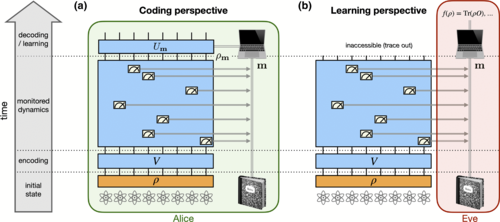Monitored quantum dynamics, the process of observing the evolution of quantum systems, has emerged as a significant area for phase structure in non-equilibrium quantum many-body systems. The study focuses on informational power, the measure of information flow from the quantum system to the classical measurement record. This undergoes a phase transition in correspondence with the measurement-induced phase transition (MIPT), determining the observer’s ability to learn properties of an unknown initial quantum state. The study also explores the role of the observer, the coding perspective, and the learning perspective in monitored quantum dynamics.
What is the Concept of Monitored Quantum Dynamics?
Monitored quantum dynamics refers to the process of observing the evolution of quantum systems, which involves unitary evolution interspersed with measurements. This concept has recently emerged as a significant area for phase structure in quantum many-body systems that are not in equilibrium. The study of monitored dynamics is conducted from the perspective of an eavesdropper who has access to the classical measurement outcomes but not to the quantum many-body system itself.
The measure of information flow from the quantum system to the classical measurement record is known as the informational power. This informational power undergoes a phase transition in correspondence with the measurement-induced phase transition (MIPT). This transition determines the eavesdropper’s inability to learn properties of an unknown initial quantum state of the system, given a complete classical description of the monitored dynamics and arbitrary classical computational resources.
The learnability transition is made concrete by defining classical shadow protocols that the eavesdropper may apply to this problem. The MIPT manifests as a transition in the sample complexity of various shadow-estimation tasks, which become harder in the low-measurement phase. The study focuses on three applications of interest: Pauli expectation values, many-body fidelity, and global charge in U1-symmetric dynamics.
How Does the Measurement-Induced Phase Transition (MIPT) Work?
The canonical formulation of the MIPT is in terms of a phase transition in the entanglement properties of ensembles of quantum trajectories. In the standard setup, the system evolves through random circuit dynamics composed of local unitary gates interrupted by local projective measurements with probability p. As the measurement rate p is tuned, the ensemble of late-time trajectories undergoes a phase transition from a disentangling phase to an entangling phase.
In the disentangling phase, trajectories display area-law entanglement at high p, corresponding to frequent measurements. In contrast, in the entangling phase, trajectories display volume-law entanglement at low p, corresponding to infrequent measurements. Models of dynamics with additional structure may exhibit different phenomenology and richer phase diagrams.
What is the Role of the Observer in Monitored Quantum Dynamics?
Recent advances in our ability to address and read out individual degrees of freedom in many-body quantum systems have motivated interest in new types of dynamics where the role of the observer is central. In these monitored dynamics, the observer’s measurements shape the evolution of the system and drive it to sharply different possible ensembles of late-time states.
These measurement-induced phase transitions (MIPTs) thus define a new paradigm for phase structure in open-systems away from equilibrium. At the same time, these technological developments have raised the salience of quantum state learning, the general problem of characterizing properties of unknown, potentially complex quantum states with as few measurements as possible.
How Does the Coding Perspective Work in Monitored Quantum Dynamics?
The coding perspective is primarily understood from the point of view of an experimentalist controlling a quantum system. Over the course of the dynamics, measurements are performed on the system either by the experimentalist herself or by a particular type of environment that broadcasts the measurement outcomes.
These measurements disturb the initial state of the system. In order to undo this disturbance as much as possible, the experimentalist can perform recovery operations on the combined final state of the quantum system and classical measurement apparatus. As a function of parameters in the monitored dynamics, typically the space-time density of measurements set by p, the experimentalist’s ability to recover her initial state undergoes a phase transition.
What is the Learning Perspective in Monitored Quantum Dynamics?
The learning perspective is the focus of this work. It is primarily understood from the point of view of an eavesdropper who has access to the classical measurement outcomes but not to the quantum many-body system itself. The measure of information flow from the quantum system to the classical measurement record is known as the informational power.
This informational power undergoes a phase transition in correspondence with the measurement-induced phase transition (MIPT). This transition determines the eavesdropper’s inability to learn properties of an unknown initial quantum state of the system, given a complete classical description of the monitored dynamics and arbitrary classical computational resources. The learnability transition is made concrete by defining classical shadow protocols that the eavesdropper may apply to this problem.
Publication details: “Learnability Transitions in Monitored Quantum Dynamics via Eavesdropper’s Classical Shadows”
Publication Date: 2024-04-05
Authors: Matteo Ippoliti and Vedika Khemani
Source: PRX Quantum 5, 020304
DOI: https://doi.org/10.1103/PRXQuantum.5.020304

